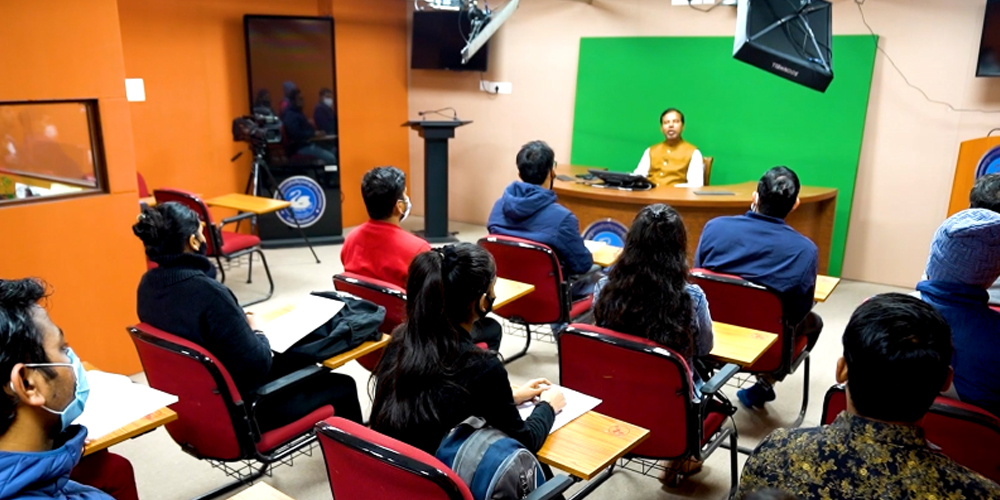The move to remote collaborating, working, learning, worshipping and communicating was underway long before the word “coronavirus” entered our lexicon. However, the onset of the pandemic shifted the transition into overdrive.
The first year, 2020, was one of upheaval and jury-rigging. People were navigating a new world of isolation and uncertainty, using whatever we could get our hands on in a pinch. Twenty-twenty-one became a year of transition, as we recognized the need for more professional tools and less of a slapdash approach.
Now, more than halfway through 2022, we see that it’s the year of changing attitudes and workflows. We’ve come to expect hybrid AV networking infrastructure to become — like the virus itself — endemic.
Expanding Bandwidth for True Collaboration
COVID-19 exposed many of the inefficiencies of workplace and education procedure. Employees and students experimented with ways to work and learn at home efficiently, trying to discern which tasks require in-person contact and which do not. The value of in-person interactions is still evident, but the days of seeing a full office or classroom, five days a week, are effectively over. Now, we face a “work/learn/contribute from anywhere” culture that requires flawless, simple connectivity between those who are in person and those who are offsite.
Bridging the gap between at-home and in-person collaborators requires deftly designed AV setups to handle the increased volume and consistency of use required for a hybrid workweek, school day or worship service. Whereas, pre-pandemic, virtual meetings were a rarity, it’s now not at all uncommon to have multiple collaborative meetings taking place simultaneously.
Related: The Great Return: Are You Prepared for Hybrid Work?
To accommodate collaborative meetings, facilities must have a robust IT infrastructure to handle multiple connections on the same network at the same time. Meanwhile, they must utilize tools that limit the load on the network. Equipment that transmits low-latency video and audio, reduces the bandwidth needed for each meeting and enables real-time interactions without lag helps ensure participants outside the workplace or learning environment are as connected as those onsite are.
Level the Playing Field
True collaboration between members can’t take place if meeting participants are receiving information on a delay. Any such delay would preclude them from chiming in with questions or suggestions. High-quality, low-latency video and audio work to level the playing field so attendees feel no advantage from being in one location versus another.
AV networking solutions are rising to the occasion, and we see this in multiple ways: upgraded virtual-collaboration tools with features to enhance the online experience; seamless integration of real-time graphics, charts and text to reinforce onscreen messages and maintain audience engagement; and efforts to recreate the experience of being together in person, ranging from screen sharing to integrating elements of augmented reality (AR) and virtual reality (VR).
Tapping into IP Infrastructure with Ease
AV networking capabilities can no longer simply be in the hands of professionals who have trained on broadcast equipment. Instead, they must be accessible to everyday people trying to do their job. Therefore, the tools a company, school or house of worship chooses to facilitate hybrid interactions must easily integrate into existing setups and offer an ease of use that puts powerful, high-quality instruments into users’ hands across all skill levels.
It’s mission critical for equipment to connect to the existing IP network easily and interact seamlessly — ideally, with limited cables so as to reduce labor-intensive setup and maintenance time and to ensure the workspace isn’t overwhelmed by the sheer number of gadgets and connections required. Finding all-in-one solutions that can suit all the institution’s needs, with minimal hassle, makes accessing digital interactions much smoother.
Additionally, AV networking technology has democratized storytelling by enabling everyday people to use professional-grade equipment with incredible ease. The ability to tap into mobile phones, game controllers and other familiar devices as storytelling tools empowers participants, lowering the barrier to entry to share information and ideas. This eliminates the necessity for extensive training to get users up to speed on how complicated video tools operate.
Benefits Beyond Simplicity
Networking an AV setup for efficient hybrid communications offers benefits beyond simplicity and ease of use. A well-networked system offers organizations maximum flexibility and scalability as needs continue to change with time. Successful institutions will expand and open new locations; naturally, remote connectivity will be integral to getting those facilities online simply and quickly.

Education institutions, enterprises and other organizations across the globe are trying to navigate the ongoing digital transformation. Photo credit: Sanskrit University.
But alongside every production studio or other permanent setup intended for regular usage, systems must also be established that offer the flexibility to respond to future lockdowns and variants, as well as new scenarios that no one has even yet imagined.
Facilities must take to heart the lessons learned from March 2020, when everyone was caught unprepared, having done minimal preparation. Part of that is bringing in smaller mobile units to guarantee gear is interoperable; it’s important to ensure cameras and other equipment are deployable in any environment, as the need arises.
A Question of Time
As the boundaries of how we work, live and learn continue to expand, the limitations and issues that differing time zones present becomes more pronounced. But even for those within the same time zone, the idea of a 9am to 5pm workday has been forever changed. The lines between work and home — between professional and family commitments — have been permanently blurred by the acceptance of this new “work/learn from anywhere” reality.
The result of this new reality is a new level of storytelling that caters to those watching and interacting live in the moment, as well as to those who might access the content on their own schedule. Simply pointing a camera at a speaker is not enough to create satisfactory content that audiences will watch and retain.
Visual aids, such as graphics and animations, help to reinforce the information, adding compelling content that is easy to follow. Such tools keep audiences engaged as they navigate the various distractions of modern life. They help ensure audience members retain and act upon key information.
Save and Store Content
It’s also imperative for each organization to have a place to save and store video content for on-demand viewing. Whether it’s on a website, app or social-media page, video communications must have a home. Recorded or archived versions should be easily findable by, and accessible to, audiences at all hours, wherever they are in the world.
More than two years after the onset of COVID-19, the digital and physical worlds have forever become intertwined. Offices and other facilities must update their plans to accommodate the new ways we communicate; moreover, they must plan for any and all eventualities. That means a setup that offers scalability, flexibility, accessibility and expert storytelling capabilities. A fully futureproofed plan must recognize that “back to normal” is not a realistic proposition, and the only way forward is full speed ahead into a hybrid future.
For additional content from and about NewTek, check out Commercial Integrator’s website archives.










